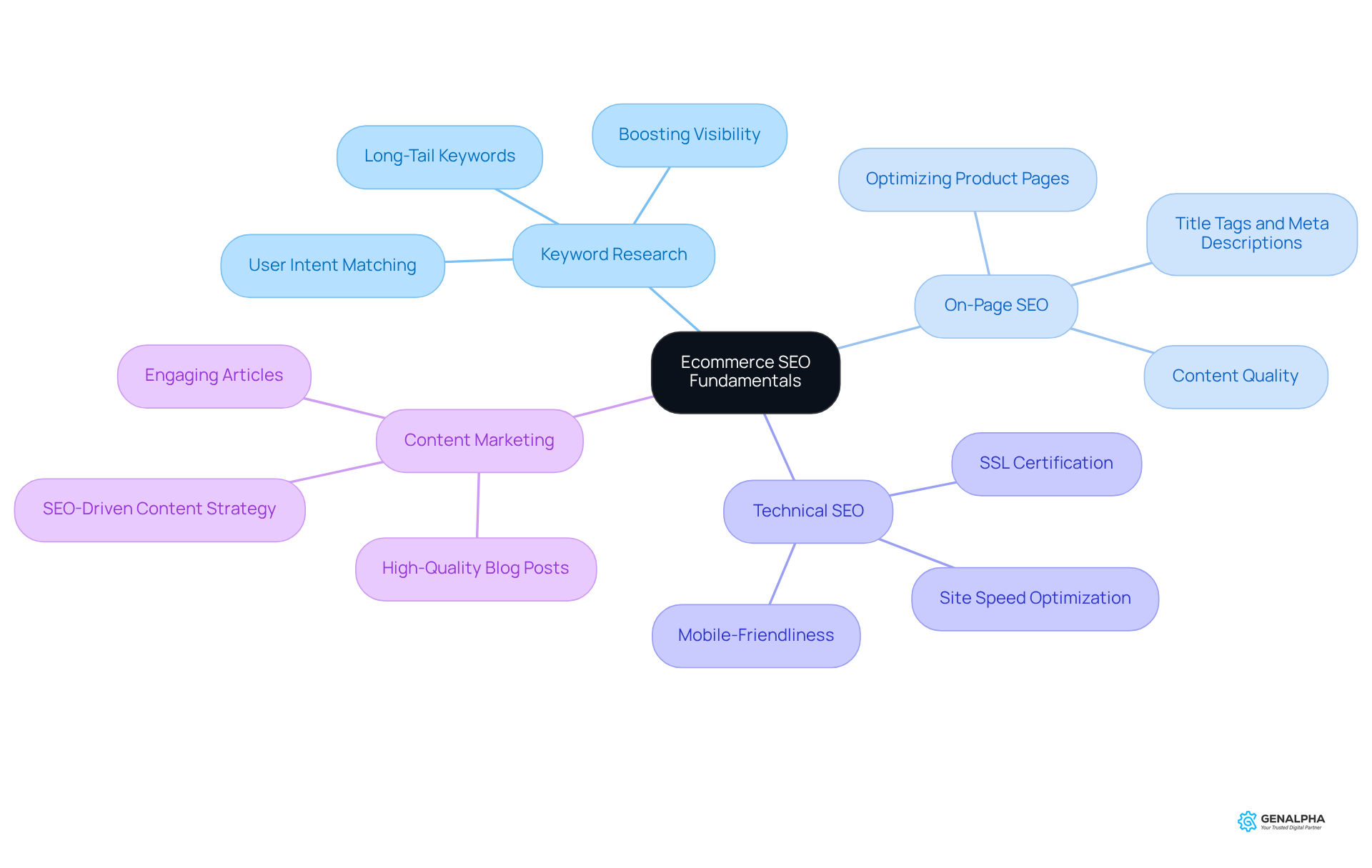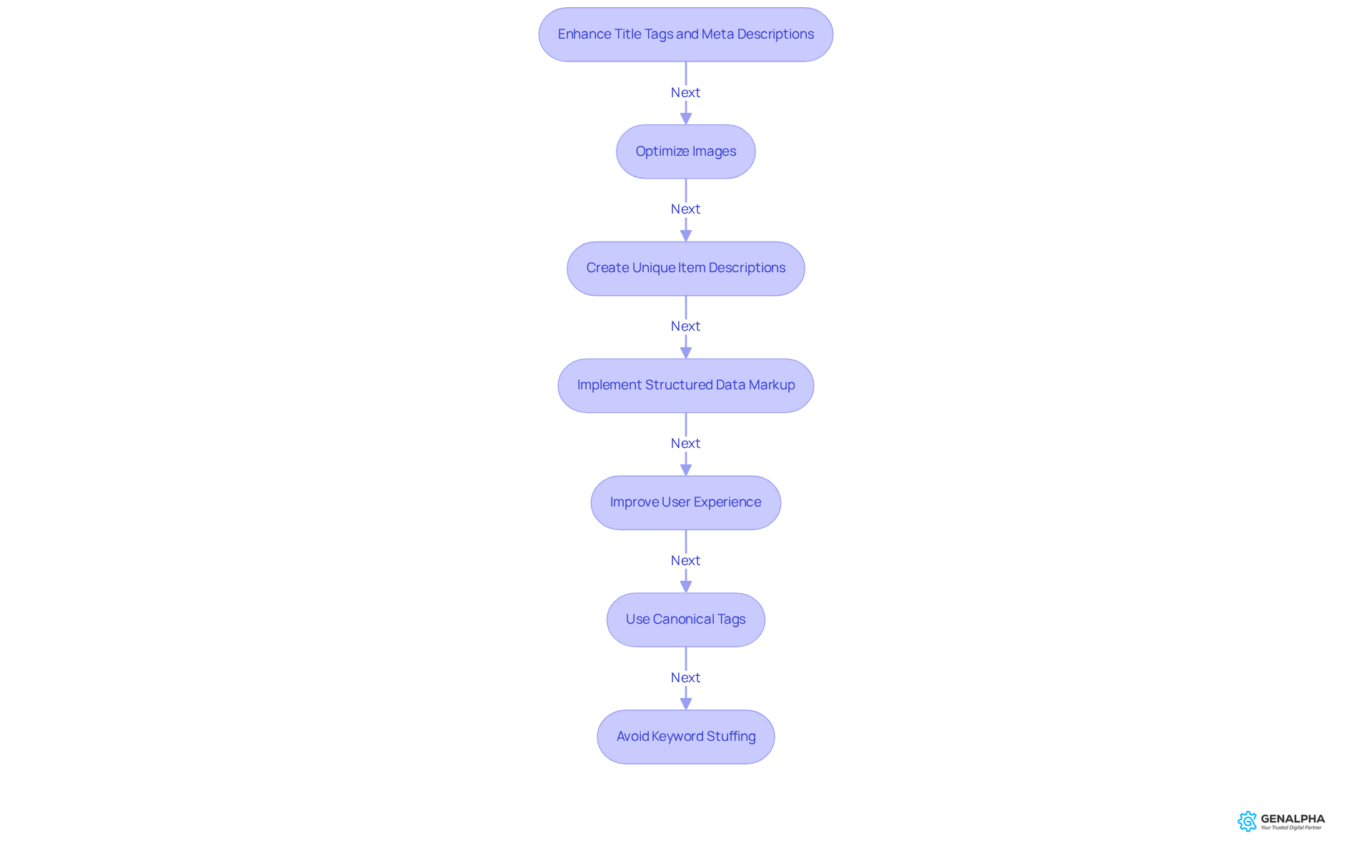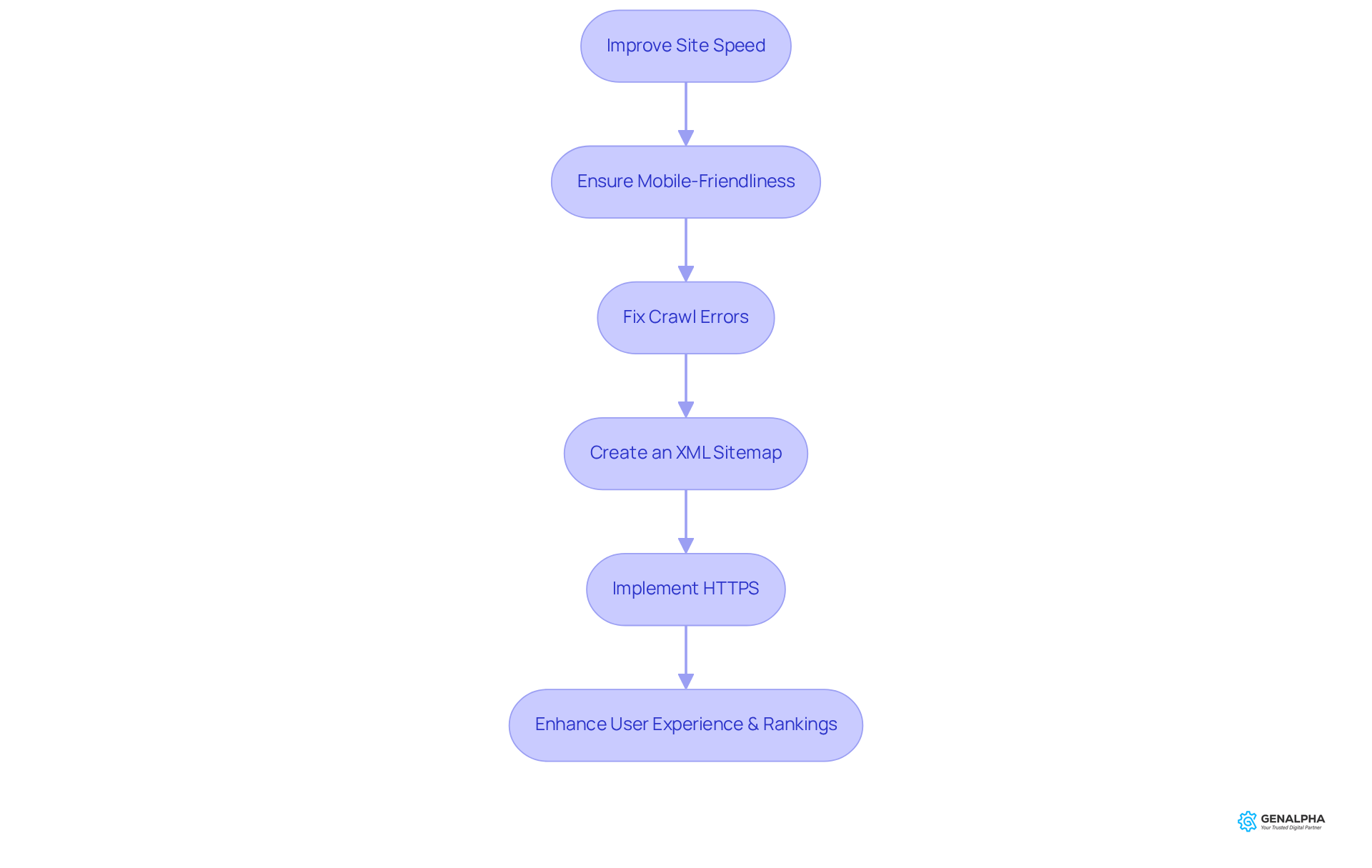Overview
Hey there! If you're a manufacturer looking to boost your online presence, then let's talk about some essential ecommerce site SEO strategies. These strategies can really help improve your visibility, drive traffic, and ultimately increase your sales. So, what are we diving into? Here are four key strategies:
- Keyword research
- On-page SEO
- Technical SEO
- Content marketing
Each of these plays a crucial role in enhancing your site's relevance and user experience. By focusing on these areas, you can position yourself to compete effectively in the digital marketplace. Sounds good, right?
Introduction
Ecommerce has really changed the game for how manufacturers connect with their customers. But let’s be honest—just having a great product isn’t enough to stand out in today’s crowded digital marketplace. To truly shine, effective SEO strategies are a must. They’re essential for boosting your online visibility and driving traffic to your ecommerce site.
In this article, we’ll explore four key ecommerce SEO strategies specifically designed for manufacturers. These insights could lead to increased sales and better customer engagement. But as the ecommerce landscape keeps evolving, how can manufacturers make sure their SEO practices are not just effective now, but also future-proof for the years to come?
Understand Ecommerce SEO Fundamentals
Ecommerce SEO is super important for making online shops more visible in search engine results pages (SERPs). Think of it as your roadmap to getting noticed! This process includes a bunch of strategies like , content creation, and technical tweaks. When manufacturers and distributors get the hang of SEO basics, they can better align their digital marketing with what customers are actually searching for, which means more traffic to their sites.
Let’s break down some key components:
- Keyword Research: This is all about figuring out the terms and phrases that potential customers use when they’re looking for products. Good keyword research not only boosts visibility but also matches user intent—essential for attracting the right traffic.
- On-Page SEO: Here, we’re optimizing individual product pages to make them more relevant and rank higher. Think well-organized descriptions, catchy title tags, and clear meta descriptions. These elements can really boost visibility and click-through rates. Don’t forget, optimizing product and category pages is crucial for visibility and driving direct purchases.
- Technical SEO: You want to ensure your website’s infrastructure is ready for search engines to crawl and index. This means optimizing site speed, making sure it’s mobile-friendly, and implementing SSL certification to build user trust and security. Did you know that mobile inquiries make up 63% of Google’s US organic traffic? That’s a big reason to prioritize mobile optimization in your SEO strategy!
- Content Marketing: Creating valuable content is key to attracting and engaging customers. High-quality blog posts and informative articles can really drive organic traffic. In fact, 61% of online consumers in the U.S. make purchases based on blog recommendations! Plus, 23.6% of eCommerce orders are tied directly to organic traffic, showing just how vital SEO is for boosting sales.
By mastering these fundamentals, manufacturers can lay a strong foundation for their ecommerce site SEO strategy, which will lead to increased online sales and happier customers. Looking ahead to 2025, when the eCommerce market is expected to hit nearly $4,791 billion, the impact of effective ecommerce site SEO strategies on online sales will be more crucial than ever. As John Mueller pointed out, digital PR can be just as important as technical SEO, highlighting the need for a well-rounded approach to SEO.

Conduct Effective Keyword Research for Targeted Visibility
To conduct effective keyword research, manufacturers should follow these steps:
- Identify Seed Keywords: Start with broad terms related to your products. For example, if you’re focusing on industrial machinery, think about keywords like 'industrial equipment' or 'heavy machinery.' This foundational step is crucial for deeper exploration.
- Utilize : Make use of tools like Google Keyword Planner, SEMrush, or Ahrefs to uncover related keywords, analyze volume trends, and assess competition levels. Additionally, tools such as Google Analytics and Google Search Console are essential for tracking performance and measuring SEO success. They provide valuable data that can inform your strategy.
- Analyze Competitors: Take a look at your competitors' websites to see which keywords they are targeting. This analysis can help you spot potential gaps in your own keyword strategy and highlight opportunities for differentiation.
- Focus on Long-Tail Keywords: Prioritize specific phrases that often exhibit lower competition and higher conversion rates. For instance, 'best hydraulic press for small businesses' is a long-tail keyword that can attract more qualified leads, boosting your chances of conversion. Notably, over 70% of all inquiry requests are for long-tail terms, making them essential for effective SEO.
- Prioritize Keywords Based on Intent: Understand the intent behind the keywords. Are users looking to buy, learn, or compare? Tailor your content to align with these intents, ensuring it meets your audience's needs effectively. As Jamie Beatty, an organic lead expert, points out, grasping user intent is vital for successfully targeting long-tail keywords.
By implementing these strategies, manufacturers can significantly enhance their visibility in search results, driving targeted traffic to their ecommerce site SEO. This approach not only improves online presence but also positions manufacturers to compete effectively in the digital landscape. Additionally, it’s crucial to avoid common pitfalls, such as overlooking user intent or focusing solely on high-volume keywords, which can hinder your keyword research efforts.

Implement On-Page SEO Techniques for Product Optimization
To optimize product pages for ecommerce site SEO, manufacturers can implement a few simple yet effective steps.
- First up, enhance your title tags and meta descriptions! Each item page should have a unique title tag and meta description that include relevant keywords. This helps search engines understand what your page is all about. Did you know that a whopping 70% of clicks go to the top five organic results?
- Next, let's talk about images. High-quality, clear images are a must! Make sure to improve image file names and alt text with relevant keywords. This little tweak can significantly boost your visibility in image searches, which is a big win for your overall SEO.
- Now, onto item descriptions. It’s super important to create original descriptions for every item. Not only does this help you avoid penalties from online platforms for duplicate content, but it also allows you to highlight key features, benefits, and specifications. Remember, unique content can really drive sales and engage customers! As SEO strategist Albert Badalyan puts it, "The majority of user clicks go to the top results on Google — to the first result alone."
- Don’t forget about structured data markup! Using schema markup helps search engines grasp the context of your items, which can enhance visibility and improve click-through rates. This technical optimization is essential for standing out in competitive rankings.
- Let’s enhance the user experience too! Make sure your product pages load quickly, are mobile-friendly, and have intuitive navigation. A positive user experience can lead to higher conversion rates. In fact, 90% of the lowest-performing eCommerce websites have UX issues. Tackling these problems is critical for boosting your overall performance.
- Canonical tags are another key player. Implementing these tags helps prevent duplicate content issues that can hurt your SEO. They guide web crawlers to recognize the original version of a page, ensuring the right content gets indexed.
- And please, avoid keyword stuffing! While it’s important to , overdoing it can confuse both consumers and search engines. Keeping your item descriptions clear and relevant is crucial for effective SEO.
By adopting these on-page SEO techniques, you can significantly improve your ecommerce site SEO, enhancing product visibility and attracting a larger customer base. So, why not start implementing these strategies today and watch your sales grow?

Optimize Technical SEO for Enhanced User Experience
Optimizing technical SEO is all about a few key practices that can make a big difference:
- Improve Site Speed: Let’s face it, nobody likes waiting for a website to load. Did you know that 40% of shoppers will abandon a site if it takes more than 3 seconds to load? And it gets worse—63% will bounce if it takes over 4 seconds! Using tools like Google PageSpeed Insights can help you spot and fix speed issues. Just a 1-second reduction in load time could boost your conversion rates by 5.6%. That’s a win!
- Ensure Mobile-Friendliness: With nearly , making sure your site is responsive is crucial. A mobile-friendly design not only enhances user experience but also aligns with Google’s mobile-first indexing, which prioritizes mobile versions for ranking. As Tina Bahadur wisely points out, "A well-organized site improves the user experience and increases your chances to rise in the rankings of online platforms."
- Fix Crawl Errors: Keeping an eye on crawl errors is essential. Regularly check Google Search Console for issues like 404 errors. Addressing these problems ensures that web crawlers can efficiently index your site, which is vital for maintaining visibility in search results. Ignoring these errors can mean missed traffic opportunities.
- Create an XML Sitemap: An XML sitemap is like a roadmap for web crawlers, helping them understand your site’s layout and find all your pages. Submitting this sitemap to Google Search Console can boost your site’s indexing efficiency, ensuring that all relevant pages get crawled and indexed.
- Implement HTTPS: Security is a top priority for online shoppers. By ensuring your site uses HTTPS, you not only protect customer data but also build trustworthiness—an essential factor in conversion rates. As the industry often discusses, "Security is a priority for online shoppers."
By focusing on these technical SEO aspects, you can significantly enhance your site’s performance, leading to better user experiences and higher search rankings. Plus, steering clear of common pitfalls like neglecting mobile optimization and failing to monitor crawl errors will only strengthen your SEO strategy. So, are you ready to take your SEO game to the next level?

Conclusion
Ecommerce SEO is a vital piece of the puzzle for manufacturers looking to boost their online presence and connect with customers in a meaningful way. By putting strong SEO strategies into action, manufacturers can really ramp up their visibility in search engine results, leading to more traffic and ultimately, increased sales. Grasping the basics of ecommerce SEO—like keyword research, on-page optimization, and technical tweaks—sets the stage for a winning digital marketing strategy.
So, what are some key strategies?
- Effective keyword research helps pinpoint the terms your potential customers are using.
- Optimizing product pages with unique content and structured data makes a big difference.
- Ensuring a seamless user experience through solid technical SEO practices is essential.
Each of these elements is crucial in drawing in the right audience and encouraging those all-important conversions. As the ecommerce landscape keeps changing, these strategies will be essential for manufacturers to stay ahead of the game.
Looking forward, we can’t stress enough how important ecommerce SEO is. With the market set to hit nearly $4,791 billion by 2025, manufacturers need to make SEO a priority—not just to meet today’s consumer demands but also to gear up for future challenges. By embracing these best practices, you’ll not only boost your visibility but also build trust and engagement with your customers, paving the way for sustained growth in the digital marketplace. So, why wait? Now’s the perfect time for manufacturers to refine their ecommerce SEO strategies and secure their spot in this ever-evolving environment.
Frequently Asked Questions
What is Ecommerce SEO and why is it important?
Ecommerce SEO is a set of strategies aimed at increasing the visibility of online shops in search engine results pages (SERPs). It helps manufacturers and distributors align their digital marketing with customer searches, leading to more traffic to their sites.
What are the key components of Ecommerce SEO?
The key components include keyword research, on-page SEO, technical SEO, and content marketing.
What is the purpose of keyword research in Ecommerce SEO?
Keyword research helps identify the terms and phrases potential customers use when searching for products. It enhances visibility and aligns with user intent to attract the right traffic.
How does on-page SEO improve product pages?
On-page SEO involves optimizing individual product pages with well-organized descriptions, catchy title tags, and clear meta descriptions, which boosts visibility and click-through rates.
What does technical SEO entail?
Technical SEO ensures that a website's infrastructure is optimized for search engines to crawl and index. This includes improving site speed, ensuring mobile-friendliness, and implementing SSL certification for user trust and security.
Why is mobile optimization important in Ecommerce SEO?
Mobile inquiries account for 63% of Google’s US organic traffic, making mobile optimization crucial for enhancing visibility and user experience in SEO strategies.
How does content marketing play a role in Ecommerce SEO?
Content marketing involves creating valuable content, such as blog posts and informative articles, which attracts and engages customers. High-quality content can drive organic traffic and influence purchasing decisions.
What impact does effective Ecommerce SEO have on sales?
Effective Ecommerce SEO strategies can significantly boost online sales, with 23.6% of eCommerce orders directly tied to organic traffic, indicating its vital role in sales growth.
What is the projected growth of the eCommerce market by 2025?
The eCommerce market is expected to reach nearly $4,791 billion by 2025, highlighting the increasing importance of effective SEO strategies for online sales.
How does digital PR relate to Ecommerce SEO?
Digital PR is considered just as important as technical SEO, emphasizing the need for a well-rounded approach to SEO that includes both elements for better online visibility and sales.




